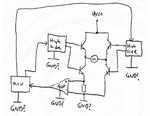bremenpl
Member level 3
Hello there,
I am trying to find some resources regarding PCB design layout for projects including power electronics components, for example high current mosfets for motor driving etc. In general I have the following questions:
I would appreciate all help.
I am trying to find some resources regarding PCB design layout for projects including power electronics components, for example high current mosfets for motor driving etc. In general I have the following questions:
- When creating a 4 layer PCB (middle layers are plane layers), should one pour GND over outer signal layers? Apart that I think it simply gives more conductivity and lowers the GND path resistance, can it do any harm?
- In a circuit when both digital and analog circuits are on board, it is recommended to separate analog GND with digital GND plane and only connect them in one place (star design). Does this apply also to power electronics GND? Should the GND be separated as well?
I would appreciate all help.

